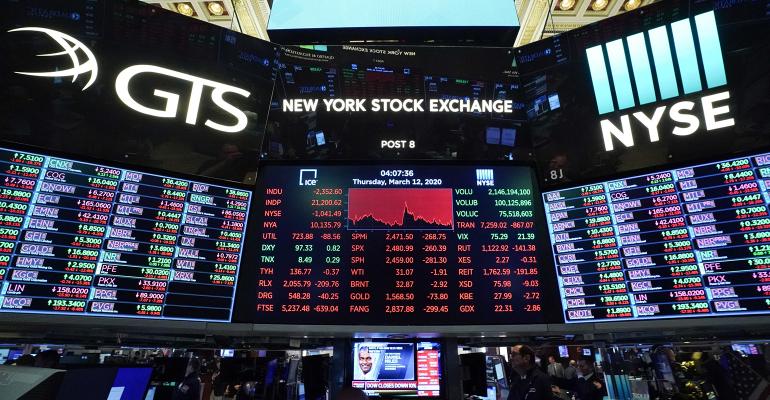(Bloomberg) -- On the last day of a historic week for global markets, there’s little sign of an end to the volatility that roiled bonds and currencies and sent stocks to their steepest plunge since the depths of the global financial crisis.
Mounting concerns that the coronavirus pandemic will spark a worldwide recession fueled a fresh round of selling in Asia on Friday. The slide triggered trading halts in Thailand, South Korea and Indonesia, while Japanese equities sank as much as 10%. Some policy makers rushed to limit wild fluctuations in currencies and sovereign debt. But then, things turned around, with assets from Australian equities to gold seeing gains. At the open of the stock market in New York, the dow was up nearly 5%.
Here’s what strategists and investors are saying about the market fluctuations:
Coming to a Head
“This is all coming to a head very rapidly,” said Brian Barish, chief investment officer in Denver at Cambiar Investors LLC, which manages about $14 billion. “Markets are making it loud and clear that a business-as-usual approach is untenable. We are buying cosmetics and booze and select industrial businesses with pretty durable forms of demand. We have not developed the courage as of yet to jump on airlines or hotels. But maybe getting close with those.”
“At this point, no sane investor should be concerned with 2020 earnings - they are cooked! - but with getting through to the other side of this.”
‘Too Late’ for Hedges...
“It’s simply too late to engage in new long volatility hedge strategies,” said Peter Cecchini, global chief market strategist at Cantor Fitzgerald LP. “Equity markets tend not to move in a straight line. We’d be monetizing hedges aggressively. Both the volatility surface and index technical setups suggest this action is prudent.”
“All the factors we look at are extreme and point to a near-term bounce, including spot VIX at the highest since 2008. We still maintain a sell-the-rally mindset, as fair value on the S&P remains roughly 2,450 on a base case but with significant risk to a downside overshoot.”
...So Try This
“While there is no free lunch, investors are seeking cost mitigation as hedges become more and more expensive,” said Amy Wu Silverman, equity derivatives strategist at RBC Capital Markets.
Selling a call spread while buying a put spread “still allows investors to retain upside should we get a sharp reversal (e.g. we have found a Coronavirus cure); meanwhile, it provides a wide expanse of protection on the downside.”
Dangerous Times
“The toxic fallout from the coronavirus pandemic’s bursting of the Fed’s ‘everything bubble’ has collided with the grotesquely over-leveraged and vulnerable U.S. corporate sector -- this puts equity markets in an even more vulnerable position,” said Albert Edwards, a strategist at Societe Generale SA known for his bearish views.
“With an anomalously low testing rate the U.S. will as a consequence suffer a high headline death rate, although the true death rate will be no worse than elsewhere. The big death rate headlines will likely hit consumer confidence very hard indeed and deepen an already likely deep recession and equity market collapse, potentially causing a significant backlash against the current U.S. administration. These are dangerous times indeed.”
‘Close to’ Bazooka
“While the market may have been disappointed that Trump did not break out the bazooka last night, the reality is the Fed came close to doing that today -- though the market remained unimpressed,” said RBC Capital Markets LLC economists Tom Porcelli and Jacob Oubina. “They promised to do $500 billion each in 1-mo and 3-mo repos for the foreseeable future and they are going to expand Treasury purchases beyond bills. For a market focused on liquidity issues, this is good first step. We continue to hear that liquidity is terrible in off-the-run Treasuries so by expanding their purchases beyond bills, they no doubt hope to alleviate that issue. The problem is, spreading around the $60 billion in monthly purchases they were already making may not be enough. We think this is just the beginning.”
Right Conditions
“Market sentiment will remain jittery in the near term as the Covid-19 outbreak continues to accelerate in the U.S. and Europe,” said Tai Hui, chief Asia market strategist at JPMorgan Asset Management. “As we have experienced in China and other parts of Asia, the right policies to contain the outbreak should work but this involves some sharp, short term pain. We are likely to go through such pain in the weeks ahead in the U.S. and Europe.”
“For markets to be less anxious, we need to see the number of new infections stabilize, as we did with China (since mid-February) and South Korea (in recent days). We also need to see fiscal and monetary policy support implementation. Hence, we are not looking at specific time or valuation to advise investors to add back equities, but instead we are looking for the right conditions.”
EM Outperformers
“We no longer recommend investors overweight emerging-market equity positions relative to euro-zone stocks” after outperformance by EM in recent days, said Mark Haefele, chief investment officer at UBS Global Wealth Management.
Safety Beats Everything
“There’s a whole host of uncertainties out there and markets aren’t sure that the policy measures they have seen so far are coherent, cohesive and coordinated enough to tackle what’s at hand,” said Vishnu Varathan, head of economics and strategy at Mizuho Bank Ltd. “It’s beside the point that we’ve gone into an area where valuations are attractive until the fright stabilizes and is alleviated. It’s difficult for markets to be convinced to be taking the risk in catching falling knives.”
Liquidity Constraints
“Despite the recent injections of liquidity from major central banks, they are not flowing into Asia,” said Eugenia Fabon Victorino, head of Asia strategy at Skandinaviska Enskilda Banken in Singapore. “As Asia braces for tighter USD funding, long USD/Asia seems to be the way to go. The dollar index continues to gain ground, re-emerging as the ultimate safe haven..”
Recession Pricing
“The fact that we saw gold -- typically a safe haven asset -- decline almost 4% during the session to below $1,600 levels suggested a ‘reach for liquidity’ moment for investors,” said Eli Lee, head of investment strategy at Bank of Singapore. “Investors also expressed their firm preference for the safety of the U.S. dollar yesterday. The USD broadly appreciated against Asian currencies, even against the safe-haven Japanese yen.”
“The equity markets have by now priced in at least a technical recession lasting two quarters, in our view. The larger question is whether we could see a longer fundamental recession.”
An Optimist’s Take
“The market needs to see clear signs of a peaking of patient count globally, especially in the U.S. and Europe,” said Satoru Matsumoto, a fund manager in Tokyo at Asset Management One Co. “Given the track record in China, I am hoping that we may see some light at the end of the tunnel by early next month.”
“I don’t personally think that this outbreak will slow global growth too much, since it doesn’t stem from a credit crunch per se. But it’s inevitable that economic activities will be hindered given the declines in asset prices. Should oil prices remain low like now, the Indian rupee will be among those that look attractive. Those with higher real rates will have room to ease further and that will spur hopes for further declines in yield. The biggest positive of all is that China is actually starting to show some signs of recovery.”
--With assistance from Cormac Mullen, Lilian Karunungan, Min Jeong Lee and Abhishek Vishnoi.
To contact the reporter on this story:
Joanna Ossinger in Singapore at [email protected]
To contact the editors responsible for this story:
Christopher Anstey at [email protected]
Michael Patterson








